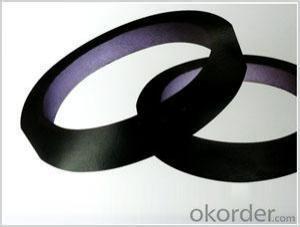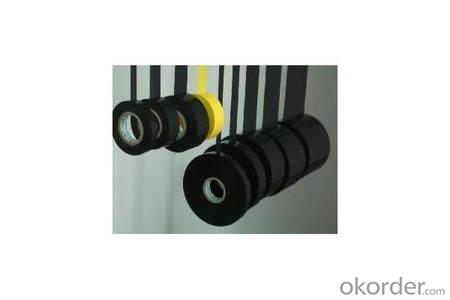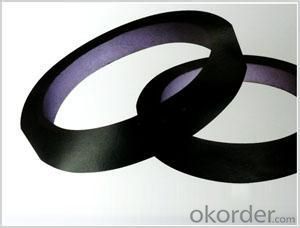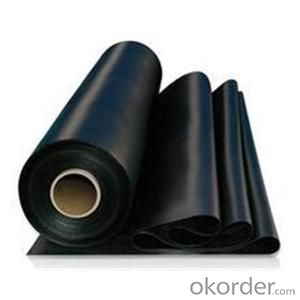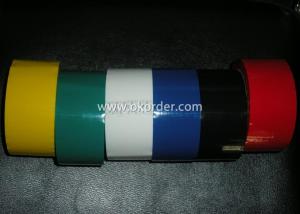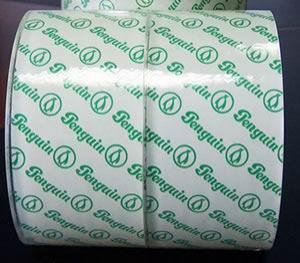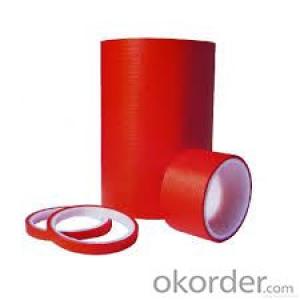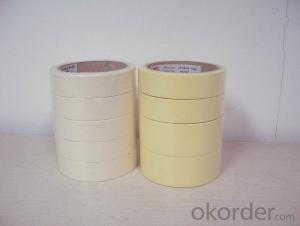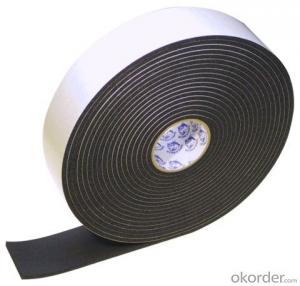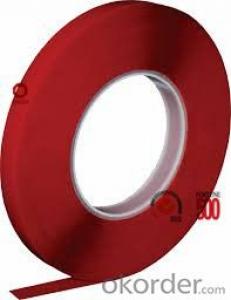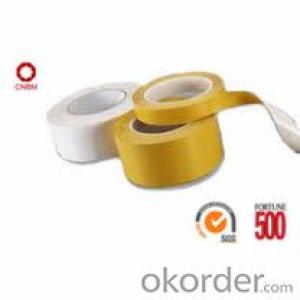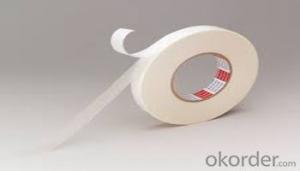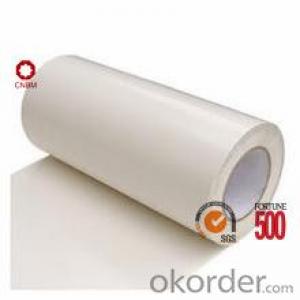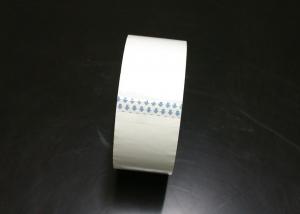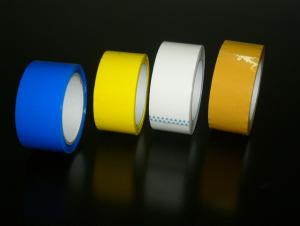Top Rated Double Sided Tissue Tape Solvent Based Acrylic Black Color Bonding Tape for Packaging
- Loading Port:
- Shanghai
- Payment Terms:
- TT OR LC
- Min Order Qty:
- 10000 m²
- Supply Capability:
- 20000000 m²/month
OKorder Service Pledge
OKorder Financial Service
You Might Also Like
Description
The Double Sided Tissue Tape is of tissue as the carrier, coating with hot melt adhesive, water based acrylic, solvent based acrylic. It is excellent in flame retardant, high temperature stability, and anti-aging. It provides well insulation to various products.
Packaging Detail:
Log Roll: Length 1000mm; width: 1050mm, 1260mm, 1040mm..
Cut Roll: As per customer’s requirements
The thickness of the tape can be customized.
Main Features of the Double Sided Tissue Tape
| Item No. | Adhesive | Thickness (micron) | Initial Tack (14#mm) | Holding Power(hour) | Adhesive to steel (N/25mm) | Temperatureresistance (DC) |
| DS-110H | solvent based acrylic | 110 | ≤120 | ≥2h | ≥17 | 60 |
General purpose of Double Sided Tissue Tape: widely used for bonding, fixing for leather, foam, sponge, garment, shoe, luggage, plastic, paper splicing and stationery.
Specifications
·World Top 500 Enterprises
·Resistance to cold, heat and aging
·Best quality and competitive price
·SGS&ISO9001
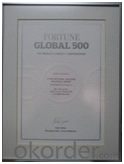
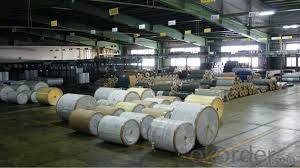
FAQ of Double Sided Tissue Tape
Q1. How about your company?
CNBM International Corporation (CNBM International) is a state-owned company and we have sound business relations with clients from over 120 countries. Currently, we have wholly-owned overseas subsidiaries and branches in 5 countries with a view to realize localization, which also represents an essential progress in our globalization target. We have over twenty years experiences.
Q2. What kind kind of service we can provide for you?
Sample of Double Sided Tissue Tape is available.
Your inquiry will be replied within 12 hours.
24 hours service
Well-trained & experienced sales representative are ready to answer you.
Q3. How long can you receive the product?
Within 7-15 working days after receiving your deposit
Welcome to contact us and visit the factory!
- Q: Does packaging tape come in different thicknesses for added durability?
- Yes, packaging tape does come in different thicknesses for added durability. The thickness of packaging tape is measured in mils, which refers to the thickness of the tape in thousandths of an inch. Common thicknesses for packaging tape range from 1.6 mils to 3.1 mils. Thicker tape is generally more durable and able to withstand heavy-duty applications. Thicker tapes are ideal for securing large or heavy packages, as they offer greater strength and tear resistance. Thinner tapes, on the other hand, may be suitable for lighter items or less demanding packaging needs. Thus, the availability of different thicknesses in packaging tape allows users to choose the most appropriate tape for their specific durability requirements.
- Q: Are there any eco-friendly options for packaging tape?
- In today's market, there are various eco-friendly options for packaging tape. Typically, traditional packaging tapes are made from plastic materials like polypropylene or PVC, which are harmful to the environment and not biodegradable. However, there have been developments in creating eco-friendly alternatives to tackle this issue. Some of these options include: 1. Packaging tape made from paper: These tapes are crafted from renewable resources like paper and natural adhesives. They are both biodegradable and compostable, making them a sustainable choice for packaging requirements. 2. Gummed paper tape, also known as water-activated tape: This type of tape is made from paper and requires water to activate the adhesive. It forms a strong bond when applied to boxes and provides tamper-proof sealing. Additionally, water-activated tape is biodegradable and can be recycled along with the packaging it is used on. 3. Biodegradable and compostable tape: These tapes are manufactured using plant-based materials such as cellulose or polylactic acid (PLA). They are designed to naturally break down over time, minimizing their impact on the environment. Some options are certified as compostable, meaning they can be added to compost piles or sent to composting facilities. 4. Recycled plastic tape: Although traditional plastic tapes are not environmentally friendly, there are recycled plastic tape options available in the market. These tapes are produced using recycled plastic materials, reducing the demand for new plastic and promoting a circular economy. When searching for eco-friendly packaging tape, it is crucial to consider certifications such as the Forest Stewardship Council (FSC) for paper-based tapes or the Biodegradable Products Institute (BPI) certification for compostable tapes. By opting for these alternatives, individuals and businesses can minimize their environmental impact and contribute to a more sustainable future.
- Q: Can packaging tape be used for sealing industrial or manufacturing goods?
- Yes, packaging tape can be used for sealing industrial or manufacturing goods. Packaging tape is designed to secure and seal packages, boxes, and cartons, making it suitable for a wide range of applications. It is commonly used in various industries, including manufacturing, to ensure the safe transportation and storage of goods. Packaging tape provides a strong and durable seal, preventing the contents from spilling, getting damaged, or being exposed to external factors such as moisture or dust. Additionally, it offers easy application and removal, making it convenient for sealing large quantities of industrial or manufacturing goods efficiently.
- Q: Can packaging tape be used for sealing paper bags?
- Indeed, paper bags can be securely sealed with packaging tape. Possessing robust adhesive properties, packaging tape effectively adheres to diverse surfaces, including paper. When appropriately applied, it furnishes a dependable and safeguarding seal for paper bags, effectively shielding their contents from spillage or external influences. To optimize adhesion, it is crucial to ascertain that the surface of the paper bag is both clean and dry prior to tape application.
- Q: Can packaging tape be used for sealing glass windows?
- No, packaging tape is not suitable for sealing glass windows. It is not designed to provide a strong and durable seal on glass surfaces. It is recommended to use appropriate window sealants or weatherstripping for this purpose.
- Q: Can packaging tape be used for sealing plastic storage baskets?
- Yes, packaging tape can be used for sealing plastic storage baskets. Packaging tape is designed to be strong and adhesive, making it suitable for securing and sealing various types of materials, including plastic. By using packaging tape, you can effectively seal the openings or seams of plastic storage baskets, keeping the contents secure and protected. However, it is important to note that the longevity and effectiveness of the seal may depend on the quality and durability of the specific packaging tape used. Additionally, it is recommended to clean and dry the surface of the plastic storage baskets before applying the tape to ensure proper adhesion.
- Q: Is packaging tape easy to remove without damaging surfaces?
- Yes, packaging tape is generally easy to remove without damaging surfaces. It is designed to adhere securely to packages, but also to be easily peeled off without leaving residue or causing damage to most surfaces.
- Q: How do I prevent packaging tape from leaving a sticky residue?
- There are several simple steps you can take to ensure that packaging tape does not leave behind any sticky residue. Firstly, it is important to choose the appropriate type of tape. Look for high-quality packaging tape that is specifically designed to leave minimal residue. Tapes with a low-tack adhesive or those labeled as residue-free are ideal. Before applying the tape, make sure the surface is clean and dry. Use a mild detergent or rubbing alcohol solution to wipe away any dust, dirt, or grease. This will improve the tape's adhesion and minimize the chances of residue formation. If you are unsure about the tape's residue potential, it is always a good idea to test it in a small, inconspicuous area first. Apply a small piece of tape and let it sit for a few hours or overnight. After removing it, check for any sticky residue. If none is present, you can proceed with confidence. When removing the tape, do so slowly and at a low angle parallel to the surface. Pulling it too quickly or at a high angle can increase the likelihood of leaving behind sticky residue. Take your time and be patient to avoid any damage or residue. If some residue remains, you can try using gentle heat or solvents to remove it. Use a hairdryer on a low setting to warm up the residue and then wipe it away with a clean cloth. Alternatively, you can apply a small amount of rubbing alcohol, white vinegar, or adhesive remover to a cloth and gently rub the residue until it dissolves. By following these tips, you can effectively prevent packaging tape from leaving a sticky residue and maintain a clean surface.
- Q: What are the different types of packaging tape available?
- There is a wide range of packaging tape options to choose from, each tailor-made for specific purposes and applications. Here are a few commonly used varieties: 1. Transparent packaging tape: This is the most commonly employed type of packaging tape due to its versatility. It is transparent and boasts a strong adhesive bond, making it ideal for sealing boxes and packages. 2. Brown packaging tape: Also referred to as "brown tape" or "packing tape," this tape is typically constructed from brown or tan-colored material and reinforced with fiberglass. It offers exceptional strength and durability for securing heavy or bulky packages. 3. Masking tape: Although not specifically designed for packaging, masking tape can be used for light-duty sealing or labeling needs. It is easily removable and leaves no residue, making it suitable for temporary applications. 4. Duct tape: Renowned for its strength and versatility, duct tape is not primarily intended for packaging purposes but can be utilized in certain situations. It possesses a powerful adhesive bond and is known for its ability to stick to various surfaces, including uneven or rough ones. 5. Filament tape: This tape is fortified with fiberglass filaments, providing incredible strength and resistance. Filament tape is commonly used for bundling or reinforcing heavy or irregularly shaped items. 6. Double-sided tape: Unlike other packaging tapes, double-sided tape has adhesive on both sides and is employed for a variety of applications, such as bonding two surfaces together or mounting objects. 7. Kraft paper tape: Crafted from a renewable resource, kraft paper tape serves as an eco-friendly alternative to plastic tapes. It requires moistening before application as it is water-activated. Kraft paper tape delivers a robust seal and is often utilized for sealing cartons or packages that contain valuable or fragile items. 8. Colored packaging tape: This tape comes in a range of colors and is commonly used for color-coding packages, labeling, or enhancing the aesthetic appeal of packages. These represent just a few of the packaging tape options available in the market. Each type possesses its own distinct characteristics and is suitable for specific packaging requirements. When selecting the appropriate tape, it is crucial to consider factors such as the weight and nature of the package, the environment it will be exposed to, and any specific regulations or requirements that may be applicable.
- Q: Can packaging tape be used for sealing plastic storage bags?
- Yes, packaging tape can be used for sealing plastic storage bags. It provides a strong adhesive bond that helps keep the bags securely sealed.
Send your message to us
Top Rated Double Sided Tissue Tape Solvent Based Acrylic Black Color Bonding Tape for Packaging
- Loading Port:
- Shanghai
- Payment Terms:
- TT OR LC
- Min Order Qty:
- 10000 m²
- Supply Capability:
- 20000000 m²/month
OKorder Service Pledge
OKorder Financial Service
Similar products
Hot products
Hot Searches

